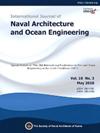双螺杆船舶自推进性能的RANS分析
IF 3.9
3区 工程技术
Q2 ENGINEERING, MARINE
International Journal of Naval Architecture and Ocean Engineering
Pub Date : 2025-01-01
DOI:10.1016/j.ijnaoe.2025.100674
引用次数: 0
摘要
本研究利用基于reynolds -average Navier-Stokes (RANS)的计算流体动力学(CFD)技术,对一艘高速双螺杆单桅水面舰艇的全尺寸自推进性能进行了综合评估。阻力、螺旋桨开放水域特性和自推进行为通过结合最近的表面粗糙度基准数据进行分析,表面粗糙度被认为是全面CFD分析的关键因素。数值预测,包括关键的自推进参数,根据从KRISO进行的模型试验推断的全尺寸性能数据进行了验证。此外,通过模拟波浪条件下由特定螺旋桨转速引起的推力引起的浪涌运动来估计船速,模拟海上试验环境。最后,通过CFD模拟、模型试验和实际海试结果比较了规定rpm对应的船速。本文章由计算机程序翻译,如有差异,请以英文原文为准。
RANS analysis of the self-propulsion performance for a twin-screw ship
This study presents a comprehensive estimation of full-scale self-propulsion performance for a high-speed, twin-screw, single-skeg surface vessel using Reynolds-averaged Navier–Stokes (RANS)-based computational fluid dynamics (CFD). Resistance, propeller open-water characteristics, and self-propulsion behavior were analyzed by incorporating recent benchmark data on surface roughness—identified as a critical factor in full-scale CFD analysis. The numerical predictions, including key self-propulsion parameters, were validated against full-scale performance data extrapolated from model tests conducted at KRISO. Additionally, ship speeds were estimated by simulating surge motion induced by thrust from specified propeller RPMs under wave conditions, replicating sea trial environments. Finally, ship speeds corresponding to the prescribed RPMs were compared across CFD simulations, model tests, and actual sea trial results.
求助全文
通过发布文献求助,成功后即可免费获取论文全文。
去求助
来源期刊

International Journal of Naval Architecture and Ocean Engineering
ENGINEERING, MARINE-
CiteScore
4.90
自引率
4.50%
发文量
62
审稿时长
12 months
期刊介绍:
International Journal of Naval Architecture and Ocean Engineering provides a forum for engineers and scientists from a wide range of disciplines to present and discuss various phenomena in the utilization and preservation of ocean environment. Without being limited by the traditional categorization, it is encouraged to present advanced technology development and scientific research, as long as they are aimed for more and better human engagement with ocean environment. Topics include, but not limited to: marine hydrodynamics; structural mechanics; marine propulsion system; design methodology & practice; production technology; system dynamics & control; marine equipment technology; materials science; underwater acoustics; ocean remote sensing; and information technology related to ship and marine systems; ocean energy systems; marine environmental engineering; maritime safety engineering; polar & arctic engineering; coastal & port engineering; subsea engineering; and specialized watercraft engineering.
 求助内容:
求助内容: 应助结果提醒方式:
应助结果提醒方式:


